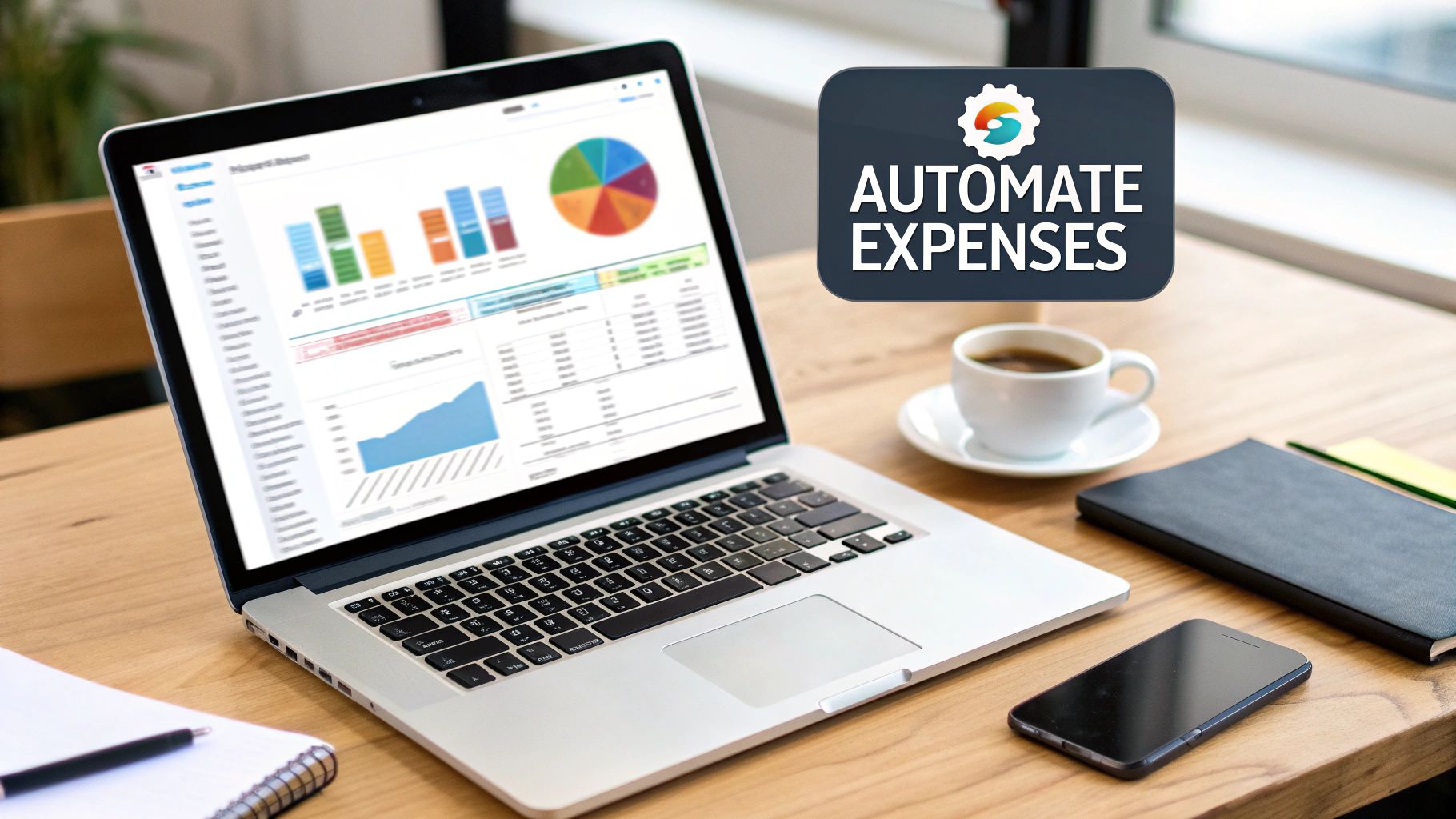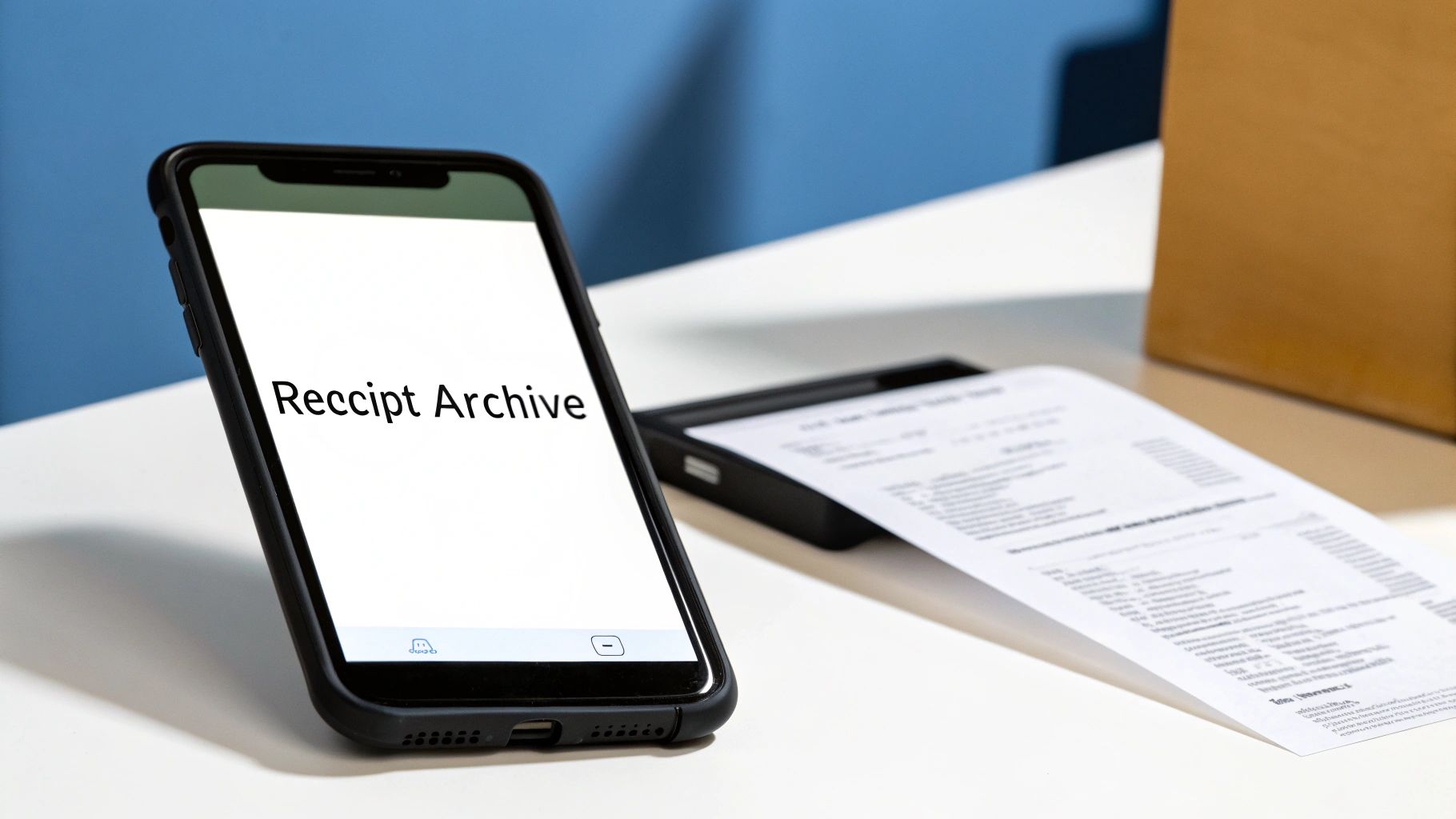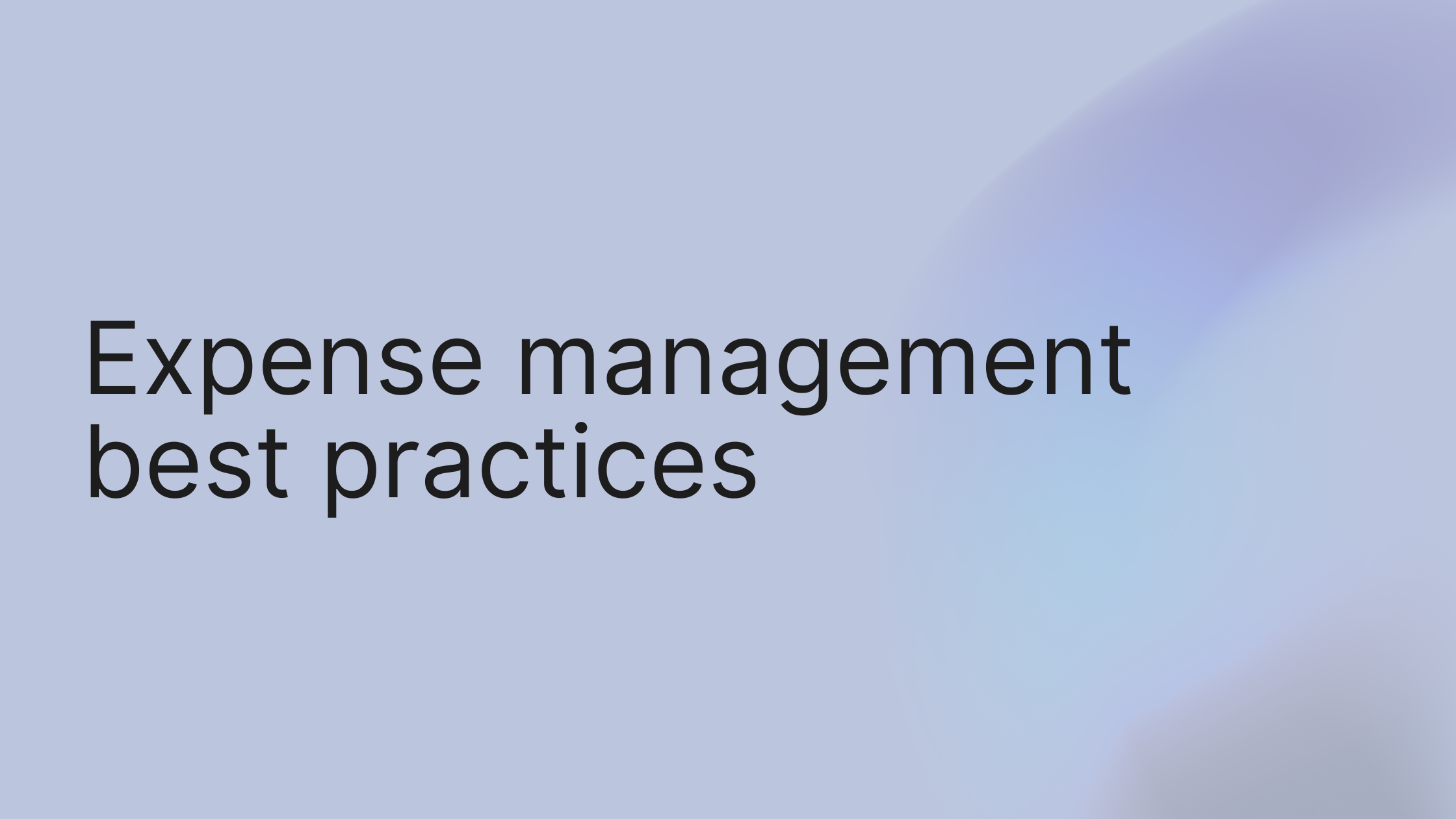Is your team drowning in a sea of crumpled receipts, complex spreadsheets, and endless reimbursement delays? The frustration is real. Chasing down expense reports costs valuable time and creates friction between teams and finance, directly impacting your bottom line. But what if you could solve the biggest headache, lost receipts, in the next five minutes? Here’s a quick win: implement a policy where employees immediately snap a photo of their receipt with their phone and email it to a dedicated address like receipts@yourcompany.com. This simple step creates an instant digital trail and ends the paper chase for good.
This is just the first step. For service businesses, where project costs, client travel, and team expenses directly impact profitability, mastering your spending is not just an administrative task, it is a strategic advantage. For example, a marketing agency that tracks campaign-specific expenses in real-time can immediately see which client projects are most profitable and adjust their strategy accordingly, rather than waiting for a month-end report. To truly revolutionize your financial management and eliminate the headache of scattered data, consider exploring effective small business expense tracking strategies.
This guide cuts through the noise to provide actionable expense management best practices tailored for the unique needs of service-based companies. We will cover everything from policy design and automation to reimbursement workflows and analytics. By implementing these clear, step-by-step methods, you can transform your chaotic process into a streamlined, automated system that saves time, reduces errors, and gives you the financial clarity needed to grow your business.
1. Create a Clear and Comprehensive Expense Policy
Is your finance team constantly fielding questions like "Can I expense this?" or "What's the meal limit for a client dinner?" Ambiguity is the enemy of compliance. When expense policies are vague, unwritten, or outdated, it leads to inconsistent spending, frustrated employees, and hours of administrative back-and-forth for your finance department.
Establishing a clear and comprehensive expense policy is a cornerstone of effective expense management. This document acts as the single source of truth, outlining precisely what is and isn't a reimbursable business expense. It removes guesswork for employees and empowers your finance team to enforce rules consistently. A well-defined policy sets clear spending limits, specifies required documentation, and details the approval workflow, preventing non-compliant spending before it even happens.
Actionable Steps to Create Your Policy
Creating a policy that works isn't about being restrictive; it's about being clear. Follow these steps to build a policy that empowers your team:
- Define Expense Categories and Set Limits: Clearly outline all permissible expense categories, such as travel, meals, software, and client entertainment. For each category, specify clear spending limits (e.g., "$75 per person per day for meals") to prevent budget overruns and ensure fairness.
- Make It Easily Accessible: Don't bury your policy in a forgotten folder on a shared drive. Host it on your company intranet or within your expense management software. Create a one-page "quick reference guide" for common expenses like travel and meals that employees can easily access on the go.
- Involve Employees in the Process: Get buy-in by involving department heads or frequent spenders in the policy creation or revision process. They can provide valuable real-world feedback on what is reasonable and practical, making the final policy more likely to be adopted without friction.
- Review and Update Annually: Business needs and costs change. Schedule an annual review of your expense policy to adjust for inflation, add new expense categories (like home office stipends), and align with the company's strategic goals. Communicate any changes clearly to all employees.
A robust policy is the foundation upon which all other expense management best practices are built. It provides the framework needed for automation to work effectively and gives you a defensible basis for managing company spending.
2. Implement Automated Expense Management Systems
Tired of chasing down crumpled receipts and manually entering expense data into spreadsheets? The endless cycle of lost paperwork, policy violations, and delayed reimbursements drains productivity and creates friction between teams. The single most impactful step for any service business is to move away from these manual, error-prone processes.
Implementing a dedicated expense management system is a foundational best practice that digitizes the entire workflow. These platforms use Optical Character Recognition (OCR) technology to automatically scan and capture data from receipts snapped with a smartphone. This eliminates manual data entry, reduces errors, and ensures every expense is logged instantly.

Actionable Steps for Implementation
Getting started with automation doesn't have to be an overhaul. Follow these steps for a smooth transition:
- Digitize Receipt Capture: The process starts with the employee. Instruct your team to use the mobile app to snap a photo of their receipt immediately. The software’s OCR technology then automatically scans the vendor, date, and amount, pre-filling the expense report.
- Automate Policy Enforcement: Configure the system to automatically flag out-of-policy expenses, such as a meal that exceeds the per-diem limit or a purchase from an unapproved vendor. This provides instant feedback to the employee and reduces the compliance burden on managers.
- Set Up Approval Workflows: Route expense reports automatically to the correct manager for approval based on department, project code, or amount. The system sends notifications to ensure timely review and reimbursement.
- Integrate with Your Accounting Software: Connect the expense platform directly to your accounting software (e.g., QuickBooks, Xero). This creates a single source of truth for financial data, automates general ledger updates, and drastically cuts down on manual reconciliation time for your finance team.
Real-World Use Case: A Digital Agency's Automation Win
A mid-sized digital marketing agency struggled with tracking project-related expenses. Their project managers were spending hours each month manually collating receipts from team members and matching them to client projects in spreadsheets.
Action Taken: They implemented an expense management platform and integrated it with their project management tool. Employees were trained to capture receipts on their phones and tag each expense with the relevant client and project code directly in the app.
Result: The agency reduced expense processing time by 75%. More importantly, they gained real-time visibility into project profitability. Project managers could now see an up-to-the-minute view of expenses against their budget, allowing them to make smarter spending decisions and ensure every client project remained profitable.
By replacing outdated manual methods with a modern, automated system, you not only improve efficiency and accuracy but also gain real-time visibility into company spending. This is a crucial step in establishing effective expense management best practices that can scale with your business.
3. Implement Pre-approval Workflows for Large Expenses
Does this scenario sound familiar? An employee returns from a conference and submits a surprisingly high expense report, including last-minute premium flights and a high-end hotel. The expense is legitimate, but it blows the project budget, forcing an awkward conversation and potentially leaving the employee out of pocket. This reactive approach creates financial uncertainty and damages morale.
A key expense management best practice to prevent this is implementing a pre-approval workflow. This system requires employees to get authorization before they make significant purchases like flights, software subscriptions, or conference registrations. It shifts spending control from a reactive, after-the-fact reimbursement model to a proactive, forward-looking approval process. This ensures every large expense aligns with company budgets and strategic goals from the very beginning, eliminating costly surprises and policy confusion.
Actionable Steps for Implementation
Setting up pre-approvals gives your finance team and project managers crucial oversight. Use these steps to integrate them smoothly:
- Define Clear Thresholds: Not every purchase needs pre-approval. Set reasonable monetary thresholds based on role, department, or project. For example, any expense over $500, all non-project software subscriptions, or any client entertainment over $200 might require sign-off.
- Automate the Request Process: Use your expense management tool to create a simple, digital pre-approval request form. This form should capture key details like estimated cost, vendor, business justification, and the associated project or client code.
- Establish a Clear Approval Chain: Route requests automatically to the right person, such as the employee's direct manager or the relevant project manager. For very large expenses, you can create a multi-step approval workflow that includes the department head or finance team.
- Link Approvals to Expense Reports: The best systems allow employees to link their final expense submission directly to the original pre-approval. This provides auditors with a complete, transparent trail from initial request to final reimbursement, simplifying reconciliation. This is a core component of business process improvement methods that strengthens financial controls.
By mandating pre-approval for significant expenditures, you empower your teams with clear spending guardrails while giving management the visibility needed to keep budgets on track. This proactive control is a hallmark of mature and effective expense management.
4. Utilize Corporate Cards and Virtual Payment Solutions
Relying on employees to use their personal cards for business expenses creates a cash flow bottleneck and an administrative nightmare. The reimbursement cycle is slow, employees are left out-of-pocket, and your finance team lacks real-time visibility into spending until reports are filed weeks later. Shifting this burden away from employees is a critical step toward mature financial operations.
Deploying a corporate card program, supplemented with virtual payment solutions, is a powerful best practice. This approach centralizes spending onto a company-owned platform, eliminating the reimbursement process for most purchases. It provides instant transaction data, allows for proactive spending controls, and drastically simplifies reconciliation by feeding data directly into your accounting software.

Actionable Steps for Implementation
Transitioning to a corporate card program enhances control and improves employee satisfaction. Here’s how to roll it out effectively:
- Choose a Card Program with Smart Controls: Select a modern card provider that offers more than just a line of credit. Look for features like the ability to set granular spending limits per employee or category, automated receipt-matching requests via SMS, and merchant-specific restrictions.
- Issue Virtual Cards for Subscriptions and Vendors: For recurring online software payments or specific vendor contracts, create single-use or merchant-locked virtual cards. This isolates risk, prevents subscription creep, and makes it easy to trace every dollar spent on a particular service or project.
- Integrate Card Feeds with Your Expense System: A non-negotiable feature is a direct integration that automatically pulls card transactions into your expense management platform. This prompts employees to attach receipts and justifications for each charge, automating reconciliation.
- Establish a Clear Usage and Audit Policy: Communicate who is eligible for a card, what types of expenses are permissible, and the process for handling exceptions. Implement a quarterly review process to audit card usage and ensure compliance with your expense policy.
By shifting from a reimbursement-based culture to a corporate card program, you improve cash flow for both the company and its employees. This strategy is a cornerstone of modern expense management best practices, giving you unparalleled control and visibility over organizational spending.
5. Establish Regular Expense Auditing and Monitoring
Is the fear of un-audited spending keeping your finance team up at night? Relying solely on employee honesty without a system of checks and balances is a recipe for undetected fraud, consistent policy violations, and missed cost-saving opportunities. The quick win is to shift from a reactive, "trust-but-don't-verify" model to a proactive, systematic auditing process.
Establishing regular expense auditing means implementing a structured review of expense reports to ensure compliance and identify financial patterns. This goes beyond simple approvals; it involves using both automated software rules and strategic manual reviews to catch anomalies. Modern expense systems can automatically flag duplicate claims, weekend spending, or expenses exceeding policy limits. Your finance team can then perform deeper, targeted manual audits on high-risk transactions, ensuring financial integrity and accountability across the board.
Actionable Steps for Implementation
A robust auditing process creates a powerful deterrent and uncovers valuable insights. Follow these steps to build your own:
- Define Your Audit Rules: Clearly document what triggers an audit. This could include expenses over a certain threshold (e.g., all client entertainment over $500), reports from specific high-spending departments, or randomly selected reports to ensure broad coverage.
- Leverage Automated Flags: Configure your expense management software to automatically flag suspicious entries. Set rules to catch duplicate receipts, expenses submitted on weekends or holidays, and spending with unapproved vendors. This allows your team to focus on exceptions, not every single line item.
- Implement a Multi-Layered Review: Combine automated checks with human oversight. For instance, an automated system might flag a high-value meal, but a manual review by a manager is needed to confirm it aligns with the project’s client-relations strategy. This blend of tech and human judgment is key.
- Communicate Findings Constructively: When a violation is found, use it as a teaching moment, not just a punitive action. Communicate with the employee to understand the context and clarify the policy. This fosters a culture of compliance rather than one of fear.
By making auditing a routine part of your workflow, you protect your business from financial risks and turn spending data into a tool for operational improvement. This is a core pillar of effective expense management best practices that drives both compliance and efficiency.
6. Implement Receipt Management and Documentation Standards
Is your team's approach to receipts a chaotic mix of crumpled papers, blurry photos, and frantic last-minute searches? This disorganization isn't just an administrative headache; it creates significant compliance risks and leaves your business vulnerable during an audit. For service-based businesses, failing to properly document client-related expenses can directly lead to lost revenue and disputed invoices.
Establishing clear standards for receipt management is a critical best practice that ensures every expense is properly validated, stored, and accounted for. This involves moving beyond paper and creating a digital-first system for capture, retention, and documentation. Modern tools use mobile apps for on-the-go scanning, while cloud storage ensures that all records are secure, searchable, and accessible for years to come. This guarantees audit readiness and provides irrefutable proof for every claimed expense.

Actionable Steps for Implementation
Creating a robust receipt management process is about consistency and clarity. Follow these steps to build a system that works:
- Mandate Instant Digital Capture: Instruct employees to photograph their receipts immediately after a purchase using your expense management app. This simple habit prevents receipts from being lost, faded, or forgotten. It also leverages OCR technology to auto-populate expense details, saving time and reducing errors.
- Establish Clear Documentation Requirements: Don't just ask for a receipt. Require employees to add essential context, such as the project code, the client name, and the business purpose for the expense. This makes review, approval, and client billing straightforward for the finance team.
- Define a Lost Receipt Protocol: Things happen. Create a standardized digital form or affidavit for employees to fill out when a receipt is genuinely lost. This form should require the same level of detail as a normal expense claim (vendor, date, amount, business purpose) and require an extra layer of manager approval.
- Integrate with Secure Cloud Storage: Ensure your digital receipts are backed up securely and organized systematically. While expense platforms handle this, it's wise to ensure your approach aligns with broader document management best practices for optimal organization, security, and compliance across your entire organization.
By standardizing how your team captures and documents receipts, you create a reliable, audit-proof trail for every dollar spent. This is a foundational element of effective expense management best practices that protects your business and simplifies financial operations.
7. Provide Regular Training and Communication
Does it feel like employees are constantly making the same policy mistakes, submitting incomplete reports, or simply forgetting the rules? Even the most sophisticated expense management system is only as effective as the people using it. Without clear and continuous education, policy confusion leads to non-compliant spending, frustrating back-and-forth corrections, and delayed reimbursements.
Ongoing training and communication are critical expense management best practices that bridge the gap between policy and practice. This involves more than just a one-time onboarding session. It's about creating a culture of clarity where employees feel confident and equipped to manage expenses correctly. Regular refreshers, policy updates, and accessible resources ensure that compliance becomes second nature, not an afterthought. This proactive approach prevents errors before they happen, saving your finance team countless hours of corrective work.
Actionable Steps for Implementation
Effective training transforms compliance from a chore into a seamless part of the workflow. Here's how to build a robust program:
- Develop a Multi-Format Training Library: Cater to different learning styles. Create short video tutorials for system walkthroughs, one-page PDF guides for quick reference on key policies (e.g., per diems), and interactive quizzes to test knowledge.
- Integrate Training into Onboarding: Make expense policy and system training a mandatory part of every new hire's first week. This sets clear expectations from day one and prevents bad habits from forming.
- Schedule Regular Refresher Sessions: Host brief, quarterly "lunch and learn" webinars or send out monthly tip emails to cover frequently asked questions or highlight recent policy changes. This keeps the information top-of-mind.
- Communicate Policy Changes Clearly: When you update your T&E policy, don't just send an email with an attachment. Announce the change through multiple channels (e.g., Slack, email, team meetings), explain the "why" behind the change, and provide updated training materials immediately. For a deeper dive into effective training methods, explore these employee training best practices.
By investing in continuous education, you empower your team to be responsible stewards of company funds. This not only improves compliance and accuracy but also fosters a more productive and positive financial culture. Well-trained employees are more efficient, leading to better overall project performance. Find out how to boost your team’s output with better processes.
8. Leverage Analytics and Reporting for Optimization
Are your expense reports just a collection of numbers sitting in a spreadsheet? If you're only tracking spending for reimbursement purposes, you're missing out on a goldmine of strategic data. Treating expenses as a reactive, administrative task means you can't proactively identify waste, negotiate better vendor deals, or forecast project costs accurately.
Leveraging analytics and reporting transforms expense data from a simple record into a powerful decision-making tool. By using the dashboards and reporting features within modern expense management software, you can visualize spending patterns, analyze trends over time, and identify cost-saving opportunities. This data-driven approach allows you to move beyond just tracking expenses to actively optimizing them for better financial health.

Actionable Steps for Implementation
Turning raw data into strategic insights requires a structured approach. Follow these steps to build a robust analytics practice:
- Define Key Performance Indicators (KPIs): Don't just track total spend. Work with department heads to identify meaningful metrics like cost-per-project, average travel expense per client, or top vendors by category. This ensures your reporting answers critical business questions.
- Automate Routine Reports: Set up your expense management system to automatically generate and distribute weekly or monthly reports to stakeholders. This could include a "Top 10 Spenders" report for department managers or a "Policy Violation Summary" for the finance team, ensuring consistent oversight without manual effort.
- Use Visualizations for Clarity: A bar chart showing vendor spending by quarter is far more impactful than a table of numbers. Use dashboards with graphs, pie charts, and maps to communicate findings effectively and make complex data easy to understand at a glance.
- Schedule Regular Review Meetings: Data is only useful if it drives action. Hold monthly or quarterly meetings with key stakeholders to review the analytics, discuss trends, and brainstorm optimization strategies based on the findings. These insights are crucial for managing your small business cash flow.
Pro Tip: Advanced Analytics for Project Profitability
For service-based businesses, the ultimate KPI is project profitability. Go beyond standard expense reports by integrating your expense data with your project management and time-tracking data.
In a platform like growlio, you can create a real-time dashboard that pulls in:
- Billable Hours: Tracked by each team member.
- Project Expenses: Captured through the expense management module.
- Project Revenue: Based on your client contract.
This unified view instantly reveals which projects are most profitable and which are at risk of going over budget, allowing you to make proactive adjustments to protect your margins.
By embracing analytics, you establish one of the most powerful expense management best practices, enabling your service business to make smarter, data-backed financial decisions that directly impact profitability.
Expense Management Best Practices Comparison
| Item | Implementation Complexity 🔄 | Resource Requirements ⚡ | Expected Outcomes 📊 | Ideal Use Cases 💡 | Key Advantages ⭐ |
|---|---|---|---|---|---|
| Create a Clear Expense Policy | Low; mainly policy writing and updates | Low; admin and communication | Consistent compliance, cost control | Companies needing clear spending rules | Reduces confusion, streamlined approvals |
| Implement Automated Systems | Moderate; requires setup and training | Medium to High; software, training | 70-80% processing time reduction | Organizations seeking to digitize workflows | Real-time tracking, error reduction |
| Implement Pre-approval Workflows | Moderate; workflow design and tech | Medium; admin overhead and systems | Budget control, fewer denied claims | Businesses with high-value spending | Prevents overruns, reduces financial risk |
| Utilize Corporate & Virtual Cards | Moderate; integration and management | Medium; card issuance and monitoring | Eliminates reimbursements, real-time data | Companies wanting control and easy reconciliation | Fast processing, fraud protection |
| Establish Regular Auditing | Moderate; ongoing audits and tools | Medium; skilled staff and software | Detects fraud, ensures compliance | Orgs focused on risk reduction | Fraud deterrence, cost savings |
| Implement Receipt Standards | Low; process changes and tech adoption | Low; training and storage systems | Improved tax compliance, faster processing | Firms needing strong audit trails | Ensures compliance, reduces paper clutter |
| Provide Regular Training | Low to Moderate; content creation | Medium; training resources and delivery | Higher compliance, fewer violations | Orgs aiming to embed policy understanding | Reduces errors, builds strong culture |
| Leverage Analytics & Reporting | Moderate to High; data tools and skills | Medium to High; analytics platforms | Data-driven decisions, cost savings | Companies focused on optimizing spend | Identifies savings, improves budgeting |
Turn Best Practices into Daily Reality
Navigating the landscape of expense management can feel like you're constantly patching leaks in a complex system. From chasing down missing receipts and deciphering cryptic credit card statements to manually entering data into spreadsheets, the administrative burden can quickly overshadow the strategic work your service business was built to do. But moving from this state of reactive chaos to proactive control isn't a distant dream; it's a direct result of implementing the right strategies.
Throughout this guide, we've explored a comprehensive suite of expense management best practices designed to transform how your business handles spending. The journey begins with laying a solid foundation: creating a crystal-clear expense policy. From there, we saw how technology acts as a powerful amplifier. By embracing automation, implementing pre-approval workflows, and leveraging corporate cards, you can build a system that is both efficient and accountable.
From Theory to Tangible Results
The true value of these practices emerges when they are integrated into your daily operations. This is not just about processing expenses faster; it's about gaining a deeper understanding of your financial health. Remember the practices we covered:
- Systematic Audits: To ensure policy compliance and identify improvement areas.
- Receipt Standards: To create a clean, auditable trail for every dollar spent.
- Continuous Education: To turn best practices into ingrained habits.
- Actionable Analytics: To connect spending directly to project profitability and fuel growth.
Mastering these concepts transforms expense management from a dreaded administrative task into a strategic asset. When you know precisely where your money is going, you can optimize project budgets, price your services more accurately, and allocate resources with confidence. This is how high-performing service businesses gain a competitive edge; they don't just manage expenses, they master them.
Your Next Step: Unify and Automate
The most critical takeaway is this: the best expense management strategies are not isolated tactics but interconnected components of a unified system. A fragmented approach, using disparate tools for each step, will always limit your potential. The path forward is to consolidate these functions within a single platform built for the unique needs of service businesses. Stop juggling spreadsheets, email chains, and separate accounting software. The real win comes from an integrated environment where project management, client billing, and expense tracking live together.
Ready to turn these best practices into your daily reality? Start your free growlio account today and see how an all-in-one platform can connect your spending directly to your bottom line.
